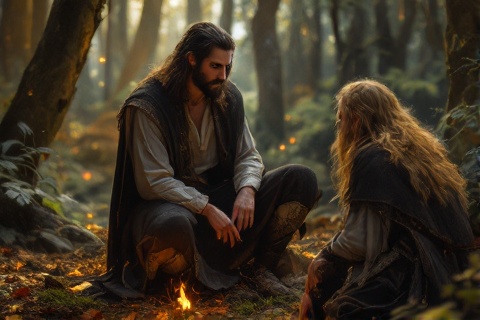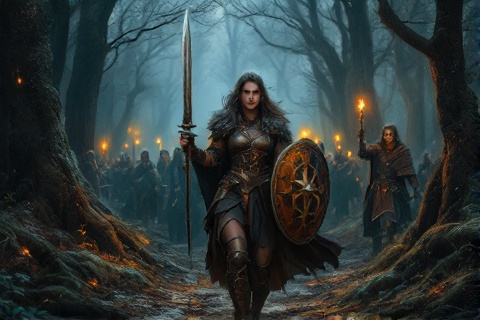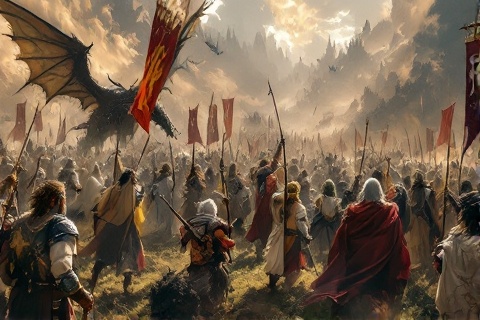
Edain: The First Allies of Elves in Middle-earth
Unveiling the Heroic Legacy of the Three Houses of Men
The Awakening of Men and Their Westward Journey

The awakening of Men occurred in Hildórien, a land far in the East
of Middle-earth, coinciding with the first rising of the
Sun in the First Age. This momentous event marked the
beginning of the race of Men, who were called the Secondborn of Ilúvatar, coming
after the Elves who had awakened under starlight ages before.
In their early days, Men encountered a mysterious and terrifying figure known as
the Dark Hunter, who was actually Morgoth or his servants
in disguise. Through cunning deception and false promises, Morgoth corrupted
many of the first Men, leading them into darkness and fear. This early
corruption would have lasting consequences for the race of Men throughout their
history.
Despite the shadow that fell upon them, three kindreds of Men showed great
courage and wisdom by choosing to journey westward. These groups, who would
later be known as the Three Houses of the Edain, were drawn by tales of a great
light in the West and sought to escape the darkness that plagued their people in
the East. Their long journey would take them through countless perils and
eventually lead them to their destiny in Beleriand.
The House of Bëor: First Friends of the Noldor

The first contact between Elves and Men occurred when Finrod
Felagund, son of Finarfin, discovered the people of
Bëor camping in Ossiriand. Drawn by their campfire songs, Finrod approached them
while they slept and began playing his harp, enchanting them with his music. The
Men awakened to find an Elf-lord among them, marking the beginning of a profound
friendship between the two races.
Following their encounter with Finrod, the House of Bëor pledged their service
to the House of Finarfin, establishing their settlements in the lands of Ladros.
This allegiance proved unshakeable, with the people of Bëor serving as faithful
vassals to their Elven lords through generations of both peace and war.
The people of the House of Bëor were distinguished by their dark hair, grey
eyes, and strong builds, traits that would later be seen in their descendants
among the Númenóreans. They were generally shorter in
stature than the other Houses but were known for their mental strength and quick
understanding.
The House of Bëor demonstrated their unwavering loyalty to their Elven allies
throughout numerous conflicts and hardships. Their faithfulness was perhaps best
exemplified by Beren, son of Barahir, whose love for the
Elven princess Lúthien led to one of the greatest
tales of the First Age. The House of Bëor suffered greatly in the wars against
Morgoth, yet their commitment never faltered.
The House of Haleth: Warriors of the Forest

The House of Haleth faced its greatest challenge when their original settlements
were besieged by Orcs. Lady Haleth, daughter of Haldad, assumed
leadership after the death of her father and twin brother, successfully
defending her people for seven days until rescue arrived. Her extraordinary
courage and leadership during this crisis earned her the position of chieftain
of her people.
After their trials, the People of Haleth established their realm in the Forest
of Brethil, a strategic location north of Doriath. This forest
realm served as a buffer between the kingdom of Doriath and the territories
threatened by Morgoth's forces, demonstrating the trust placed in them by King
Thingol.
Unlike the other Houses of the Edain, the Haladin maintained their independence
while forming an alliance with the Elves of Doriath. King Thingol granted them
permission to dwell in the Forest of Brethil in exchange for guarding the
Crossings of Teiglin. This arrangement satisfied both their desire for autonomy
and their commitment to the fight against Morgoth.
The People of Haleth developed exceptional skills in woodcraft and defensive
warfare, adapting to life in the dense forest of Brethil. They became masters of
stealth and guerrilla tactics, using their intimate knowledge of the woodland to
defend their borders. Their unique fighting style and fierce independence set
them apart from the other Houses of the Edain.
The House of Hador: Golden Warriors of Dor-lómin

The House of Hador, the third and greatest of the Houses of the Edain, was
renowned for being the tallest and most numerous of the Three Houses. Their
people settled in the lands of Dor-lómin, where they grew
into a mighty folk whose strength would become legendary throughout Beleriand.
Members of the House of Hador were easily recognizable by their golden hair,
blue eyes, and impressive physical stature. These distinctive features would
later become characteristic of the people of Rohirrim, who descended from the
House of Hador through the Third House of the Northmen.
As vassals of High King Fingolfin, the House of Hador
ruled Dor-lómin with great wisdom and valor. Their realm served as a crucial
defensive position against Morgoth's forces, and their warriors were among the
most skilled in all of Beleriand. The trust placed in them by the High King of
the Noldor demonstrated their exceptional status among the
Edain.
Among the many legendary figures produced by the House of Hador, none were more
renowned than Húrin and his brother Huor. Húrin became the greatest warrior
among Men in the First Age, while both brothers achieved the remarkable feat of
visiting the hidden city of Gondolin. Their descendants,
particularly Túrin Turambar and Tuor, would go on
to play pivotal roles in the history of Middle-earth.
Alliances with the Eldar
The relationship between the Edain and the Elves proved transformative for the
Men of the Three Houses. From their Elven allies, they learned advanced
languages, including Sindarin and, for some, even the High-elven tongue of
Quenya. The Edain also acquired knowledge of crafts, lore, and customs that
elevated their civilization far above that of other Men.
Deep friendships formed between many of the Edain and their Elven allies,
transcending the usual boundaries between the two races. Notable examples
included the bond between Finrod Felagund and the House of Bëor, and the
profound friendship between Húrin and Turgon of Gondolin. These relationships
were marked by mutual respect and trust, though also touched by the poignancy of
Men's mortality.
Throughout the Wars of Beleriand, the Edain proved themselves steadfast allies
to the Elves, fighting alongside them in countless battles against Morgoth's
forces. Their courage and loyalty made them invaluable partners in the struggle
against darkness, despite their relative youth and shorter lives compared to the
Elves.
The First Age saw both the greatest achievements and the most devastating losses
for the alliance between Elves and Edain. Together they achieved victories that
neither could have won alone, but they also shared in terrible defeats and
sorrows. The unions between Beren and Lúthien, and
later Tuor and Idril, became symbols of the special bond between the two races.
Great Deeds and Sacrifices

The Edain participated in all the major conflicts against Morgoth, from the
Dagor Bragollach to the War of
Wrath. Their warriors fought alongside the greatest
Elf-lords of the age, proving their valor in countless battles across Beleriand.
Despite being mortal and more vulnerable than their immortal allies, they never
hesitated to face the full might of the Enemy.
The cost of their loyalty was immense, with many of the Edain giving their lives
in defense of Beleriand. The House of Bëor was nearly destroyed in the Dagor
Bragollach, while the People of Haleth faced constant attacks in their forest
realm. The House of Hador suffered grievously in the Nirnaeth Arnoediad, where
many of their greatest warriors fell.
Despite seemingly impossible odds, heroes of the Edain achieved legendary feats
that earned them eternal renown. Beren's quest for the Silmaril, though driven
by love for Lúthien, became one of the most crucial achievements in the war
against Morgoth. Other heroes like Húrin Thalion withstood torture and
imprisonment for decades without surrendering to the Enemy's will.
Even in the face of devastating losses and the gradual conquest of Beleriand by
Morgoth's forces, the Edain maintained their allegiance to the Elves. Their
unwavering loyalty, even when all seemed lost, proved essential in the final
victory against Morgoth. This steadfastness would eventually earn them a reward
beyond their greatest expectations.
Legacy and the Gift of Men
After the War of Wrath and the defeat of Morgoth, the Valar
rewarded the Edain for their loyalty and sacrifices by raising the island of
Númenor from the sea. This magnificent island, shaped like a
five-pointed star, was located closer to the Blessed Realm than any other mortal
lands. The surviving Edain were granted this gift as a new homeland, where they
established the greatest kingdom of Men in Middle-earth's history.
The descendants of the Edain became known as the Númenóreans, and later, after
the Downfall of Númenor, as the Dúnedain in Middle-earth. These inheritors of
the Edain's legacy were blessed with longer life spans and greater wisdom than
other Men, preserving much of the nobility and learning of their ancestors. In
both the Northern and Southern Kingdoms they established during
the Second Age, they maintained many traditions from their First Age forebears.
The Gift of Men, as their mortality was known to the Elves, set the Edain apart
from their immortal allies. While initially seen as a source of grief, this gift
was actually Ilúvatar's blessing to his Younger Children, freeing them from
bondage to the circles of the world. This fundamental difference between Elves
and Men would shape much of the mythology and history of Middle-earth.
The influence of the Edain continued long after the First Age through their
descendants, the Dúnedain. Even into the Third Age, the heirs of the Edain
played crucial roles in Middle-earth's history, with the Rangers of the North
maintaining their ancient traditions and bloodlines. The legacy of the Three
Houses ultimately culminated in Aragorn, who
reunited the sundered realms and restored the glory of the Númenórean kingdoms.
